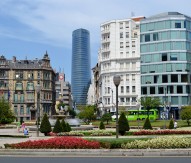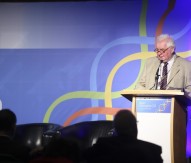

© Intel Corporation
Building Intel Labs Europe
As the chief technology officer of Intel Corporation and managing director of Intel Labs, Justin Rattner directs the company’s global research efforts in processors, programming, systems, security, communications and, most recently, user experience and interaction. He also oversees the funding of academic research worldwide through the corporation’s science and technology centres and research institutes. Intel Labs Europe is an open innovation ecosystem linking the firm’s European R&D centres and helps to connect the company to a range of academic institutions and industrialists.
During the ‘Open Innovation 2.0’ conference in Ireland, Rattner was honoured with the inaugural ‘21st Century Industrial Innovation’ award at the first Innovation Luminary Awards. Speaking to Pan European Networks during the conference, Rattner began by explaining what it meant to him to win the award and outlined the development of Intel Labs Europe.
In my work, the satisfaction comes from bringing a new technology to the market and seeing one of our great ideas happen.
In 2008, Martin Curley (Director of Intel Labs Europe) and I began talking about how to change the image of Intel in Europe. We saw tremendous potential in Europe’s innovation and knowledge-based economy and capabilities. At the same time, we were able to envision an open innovation based R&D network for Intel in Europe. We were in Brussels when it all started and I remember going from directorate to directorate at the European Commission and hearing that same message: ‘that they would love for Intel to participate in European programmes – take AMD for an example, they’ve really engaged here’.
Martin and I started this dialogue and we thought about how can we link all of these independent R&D centres; I think for multinational corporations, that is a key problem. Often these R&D centres are not connected to one another, but do link back to their home country, in our case the United States. We had a fairly substantial headcount in Europe, even without Intel Labs, but there was no connection between them. So we set about creating a network and making our colleagues feel part of a network and that’s what Intel R&D in Europe now is; it’s remarkable how quickly that was embraced.
We have built Intel Labs Europe into a formidable network and the external perception has changed dramatically. The internal result was even more valuable to Intel because these colleagues had many of the same problems. By having people working together in effectively the same time zone, it gives them the opportunity to connect with each other and explore ‘what should we be doing’, ‘how did you do this’ and ‘how can we leverage one another’.
That’s the way I perceive this award, the recognition of the changing the perception of Intel in Europe.
Intel Labs has created an innovation eco-system with partners across Europe, a network the European Institute of Innovation and Technology (EIT) is now replicating in other industrial sectors. What do you think the EIT can learn from Intel Labs in building its innovation eco-system?
The way we try to collaborate is through direct engagement, both with government and other industrial partners, and also with universities in what I think is a different way than what is traditionally done with the academic community.
For many years, we did it the same way: universities would come in and say ‘here’s a research project, we’d like your sponsorship’. We would then give them a cheque, a mentor and have somebody internally watch over them. Over the years, I think we learnt that’s not nearly as tight a connection as it really takes to engage two parties and ultimately transfer a technology, product or service to a wider audience, even if it’s a wider internal audience.
You need to literally exchange people in order to make it work. In particular, you need to bring industrial people onto the campus and that seems to spark the magical ingredient. In our case at Intel, there is somebody who is right amidst their academic colleagues and it creates a different kind of chemistry. Students are also thrilled as they sense, even if they don’t have direct experience, the different way industrial researchers and academics assess problems. Many academics have told me tell me that they often struggle with choosing a direction because they don’t know which is likely to produce the greatest long-term benefit. Yet speaking to somebody from Intel may influence their choice of direction. I think there is the need for sustained engagement.
I think Intel has also changed the ownership model. Now this is more from the industrial partners’ perspective, but many multinational corporations carry out their academic funding through a separate organisation and so the R&D organisation itself is somewhat distant from it.
Each of our university relationships is actually owned by one of the research or product divisions and I hold my research VPs responsible for those relationships. I treat those relationships as if they include combined staff – the Intel people and the university academics were part of the same organisation. That slight shift in perspective dramatically changes the relationship.
Justin Rattner





